Construction[edit]
The Chenab Rail Bridge was originally intended to be completed in December 2009.[14] However, in September 2008, the project was halted due to fears over the bridge’s stability and safety.[15] Work on the bridge restarted in 2010,[16] with the plan to complete it in 2015.[17]
The design and construction was awarded to Afcons Infrastructure,[18] a part of the Shapoorji Pallonji Group, the third-largest construction group in India, with the help of IISc Bangalore. Major construction decisions were taken by Konkan Railway Corporation. The Defence Research and Development Organisation (DRDO) helped in the design of the bridge, making it blast-proof using special steel.[19]
The erection scheme for the bridge is a project in itself. Two pylons (about 130 m and 100 m high) were erected on either side of the river, and two auxiliary self-propelled cable cranes (capacity of 20 tonnes each) were used to tow temporary auxiliary ropes across these pylons. The ropes were used to support the partly finished arch parts. After arch completion, the trusses will be added, finally the girder will be constructed as a horizontal sliding type platform.
Project status[edit]
- Jul 2017: Construction work resumed on the bridge.
- Nov 2017: The work bridge’s arch is was expected to be completed By May 2019.[3]
- Nov 2018: The bridge is now under active construction.[20]
- Dec 2018: The project was expected to be completed by the end of 2019, but at this time, it seems unlikely.[21][22]
- Aug 2019: 80% of construction work has been completed on the bridge, and is expected to be opened in mid-2020.[23]
- Nov 2019: 83% work has been completed on the bridge, and is now expected to be opened in March 2021.[24]
- Jan 2020: It is now expected to be opened in December 2021.[25]
- April 2021: Work on both the ends of the bridge’s arch is finally completed. It is now expected to be opened in 2022.[26][2]
- June 2022: About 90% of construction work has been completed, and is now confirmed to make the bridge operational by December 2022.[27]
Maintenance[edit]
Regular painting of large bridges is an intimidating task; hence, a painting scheme was developed, having renewal of over 15 years, compared to approx. 5 to 7 years in most other Indian railway bridges.[28]
S. JAYABARATHAN [JULY 23, 2022]
- நங்கூரி
- ஷோபாசக்தியின் புதிய நாவல் ஸலாம் அலைக்
- ‘பண்ணையில் ஒரு மிருகம்’ – எழுதியவர் டாக்டர் நடேசன்
- பொங்கியது பால்
- இந்தியாவின் ஜம்மு-காஷ்மீர் இமயச் சரிவில் உலகிலே உயர்ந்த இரும்பு வளைவு இரயில் பாலம்
- தக்கயாகப் பரணி [தொடர்ச்சி]
- ஐனநாயகச் சர்வாதிகாரம்
- பூதக்கோள் வியாழன், வெள்ளிக்கோள் இடையே உள்ள ஈர்ப்பு விசை மாறுதலால், பூமியின் சுற்றுப்பாதை மாறிப் பெருத்த உயிரினப் பாதிப்பு நேரலாம்
- மேடம் இன்னிக்கு…
- கைவசமாகும் எளிய ஞானம்
- ரசவாதம்
- உன்னுள் இருந்து எனக்குள்

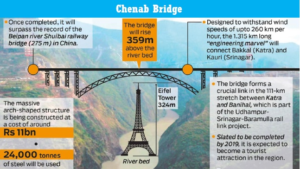
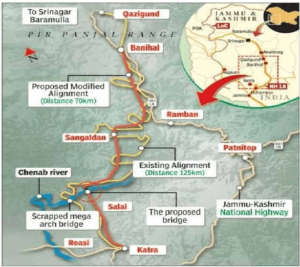
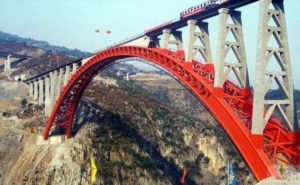
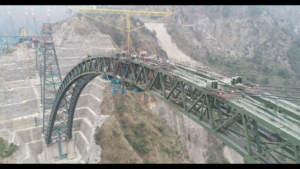
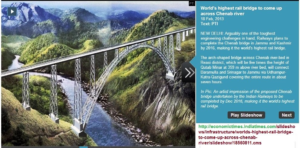

புதுச் சேர்க்கை
Interesting Facts about the Chenab Railway Bridge
Given below are some interesting facts on the Chenab Railway Bridge.
The total cost estimated of the Chenab rail bridge is Rs 1,486 crores.
The Chenab bridge covers a total length of 1,315 metres.
There are 17 spans in total over the Chenab Rail Bridge.
The life of the Chenab Railway bridge is 120 years.
Trains are allowed to pass across the Chenab bridge at a maximum speed of 100 kilometres/hour.
The highest bridge in India has been designed by consulting DRDO (Defence Research and Development Organisation).
The Chenab Bridge is designed to withstand wind speed up to 266 kilometres/hour.
It is designed to bear earthquakes of up to 8 magnitudes.
For joining the different parts of the bridge, approximately 584km (Jammu to New Delhi) of welding has been done.
For the first time, the Indian Railways have launched the curved viaduct portion by using the method of End-launching.
Warning and health monitoring systems have been extensively planned through state-of-art instrumentation.
Srinagar’s cable crane pylon stands at the height of 127 metres, making it higher than Delhi’s Qutub Minar (72 metres).
For testing the welds, a phased array ultrasonic machine has been used by the Indian Railways for the first time.
Features of the Arch of the Chenab Bridge
Here are some of the features of the spectacular arch of the Chenab River Railway Bridge.
The Chenab River bridge is 35m higher than the world-famous Eiffel Tower in Paris.
The arch is made by using boxes of steel. The boxes will be stuffed with concrete to improve stability.
The arch of the Chenab River bridge weighs 10,619MT.
A first in the Indian Railways history, the members of the arch were erected by using overhead cable cranes.
The construction of the Chenab River Rail Bridge involved the usage of 28,660 Meta Tons of steel.
For structural detailing of the Chenab River bridge, Tekla software has been used.
List of Contractors Involved in the Chenab River Project
Below is the list of the contractors who were actively involved with the Chenab River Project.
Department Name of Project Contractor
Foundation Protection Designer Indian Institute of Science (IISc), Bangalore
Slope Stability Analysis Indian Institute of Technology (IIT), Delhi
Executing Agency Konkan Railway Corporation Ltd.
Seismic Analysis Indian Institute of Technology (IIT), Delhi & Roorkee
Proof Consultant for Foundation and Foundation Protection M/s COWI, UK
Arch Designer M/s Leonhart, Andra and Partners (Germany)
Viaduct and Foundations Designer M/s WSP (Finland)
Executing Agency Konkan Railway Corporation Ltd.
Challenges Faced while constructing the Chenab Railway Bridge
Here are the challenges faced while constructing the Chenab Railway Bridge.
The rugged and mountainous Himalayan terrain posed a threat to the construction of the Chenab Rail Bridge. 900 metres tall cable cranes were installed on both sides of the Chenab gorge to build the arch of the bridge.
At such a high altitude, the bridge construction was festered with winds up to 50-60 kmph. The construction work was also hampered because of frequent and unprecedented rains, thunderstorms, landslides and snowfall.
This is why assembling the arch showcased the great work projection of the engineering skill.
Work on the arch construction started back in 2005. It was only finally linked after 16 years in March 2021.
Analysis for tunnel construction and earthquake also posed a challenge due to the persisting winds and the treacherous terrain.
Never Seen before view from Crown of Arch of Chenab Bridge
INFORMATION
1. https://www.railway-technology.com/projects/chenab-bridge-jammu-kashmir/
2. https://youtu.be/3sgcG40gYIM
3. https://structurae.net/en/structures/chenab-river-bridge
4. https://sites.google.com/site/watsanghathan5/86
5. https://en.wikipedia.org/wiki/Chenab_Rail_Bridge
6. https://youtu.be/3sgcG40gYIM
7. https://youtu.be/iI6tTvM3Tl8
பதிவாசிரியரைப் பற்றி
சி.ஜெயபாரதன்
அணுசக்தி ஆக்கப் பணியில் பொறியியல் துறைகளில் 45 ஆண்டுகளுக்கு மேலாக இந்தியா, கனடாவில் அனுபவம் பெற்று, இப்போது ஓய்வில் தமிழ் இலக்கிய படைப்புப் பணியில் முழு நேரமும் ஈடுபட்டிருக்கிறார். 1960ஆம் ஆண்டு முதல் இவரது விஞ்ஞானக் கட்டுரைகள், கதைகள், கட்டுரைகள் பல கலைமகள், மஞ்சரி, தினமணிக் கதிர், இதயம் பேசுகிறது, மயன், தாய், காலம் இதழ்களில் வெளிவந்துள்ளன. இவரது ஆக்க வினைகளுக்கு அணுசக்தி நூல் 1964இல் சென்னை பல்கலைக்கழகத்தின் மாநில முதற்பரிசு பெற்றது. கணினித் தமிழ்வலைப் பதிவுகள் பின்னிப் பிணைக்கும் புதிய உலகிலே, கடந்த 15 ஆண்டுகளாக 800க்கும் மேற்பட்ட விஞ்ஞானக் கட்டுரைகள், கவிதைகள், கதைகள், நாடகங்கள் பற்பல அம்பலம், திண்ணை, பதிவுகள், அந்திமழை, நதியலை, வல்லமை போன்ற வலைத் தளங்களில் பல்லாண்டுகள் வந்துள்ளன. இவரது நீண்ட தமிழ் நாடகங்கள், மும்பையிலும், சென்னை கல்பாக்கத்திலும் அரங்கேறியுள்ளன.
இதுவரை 27 நூல்கள் வெளிவந்துள்ளன: ஆக்க வினைகளுக்கு அணுசக்தி, வானியல் விஞ்ஞானிகள், அணுசக்தி, தாகூரின் தமிழ்க் கீதாஞ்சலி, அணுவின் ஆற்றல், இந்திய விஞ்ஞான மேதைகள், சீதாயண நாடகம், சீதாயணம் படக்கதை, கீதாஞ்சலி, ஆபிரஹாம் லிங்கன், சாக்ரடிஸ், நெப்போலியன், ஜோன் ஆஃப் ஆர்க், முக்கோணக் கிளிகள் படக்கதை, கலீல் கிப்ரான் கவிதைகள், விண்வெளி வெற்றிகள், அணுமின்சக்தி பிரச்சனைகள், மெய்ப்பாடுகள், அணுசக்தியே இனி ஆதார சக்தி, நைல் நதி நாகரீகம், உலகிலே உன்னத பொறியியற் சாதனைகள், எழிலரசி கிளியோபாத்ரா, காதல் நாற்பது, உன்னத மனிதன், பிரபஞ்சத்தின் மகத்தான நூறு புதிர்கள் (தொகுப்பு 1 & 2), அண்டவெளிப் பயணங்கள். Echo of Nature [English Translation of Environmental Poems (வைகைச்செல்வி வெளியீடு].
See author’s posts
Tags: சி. ஜெயபாரதன்